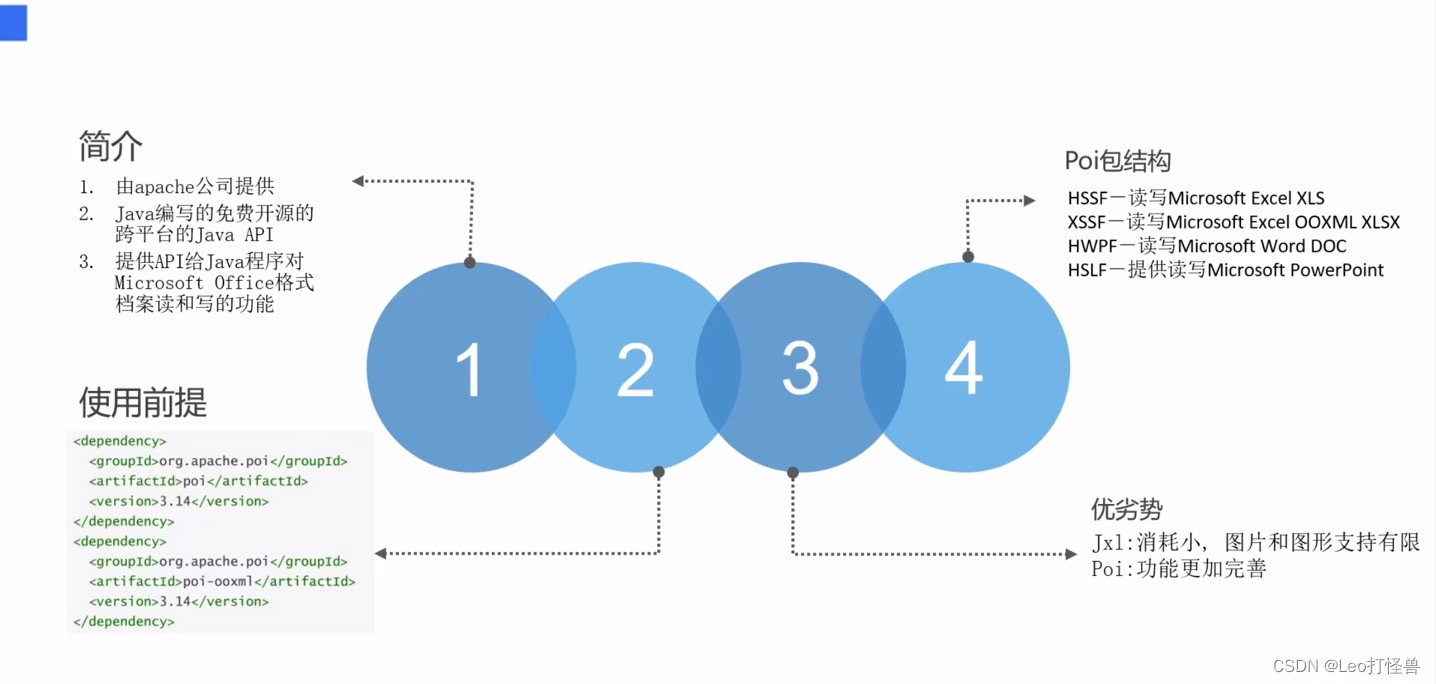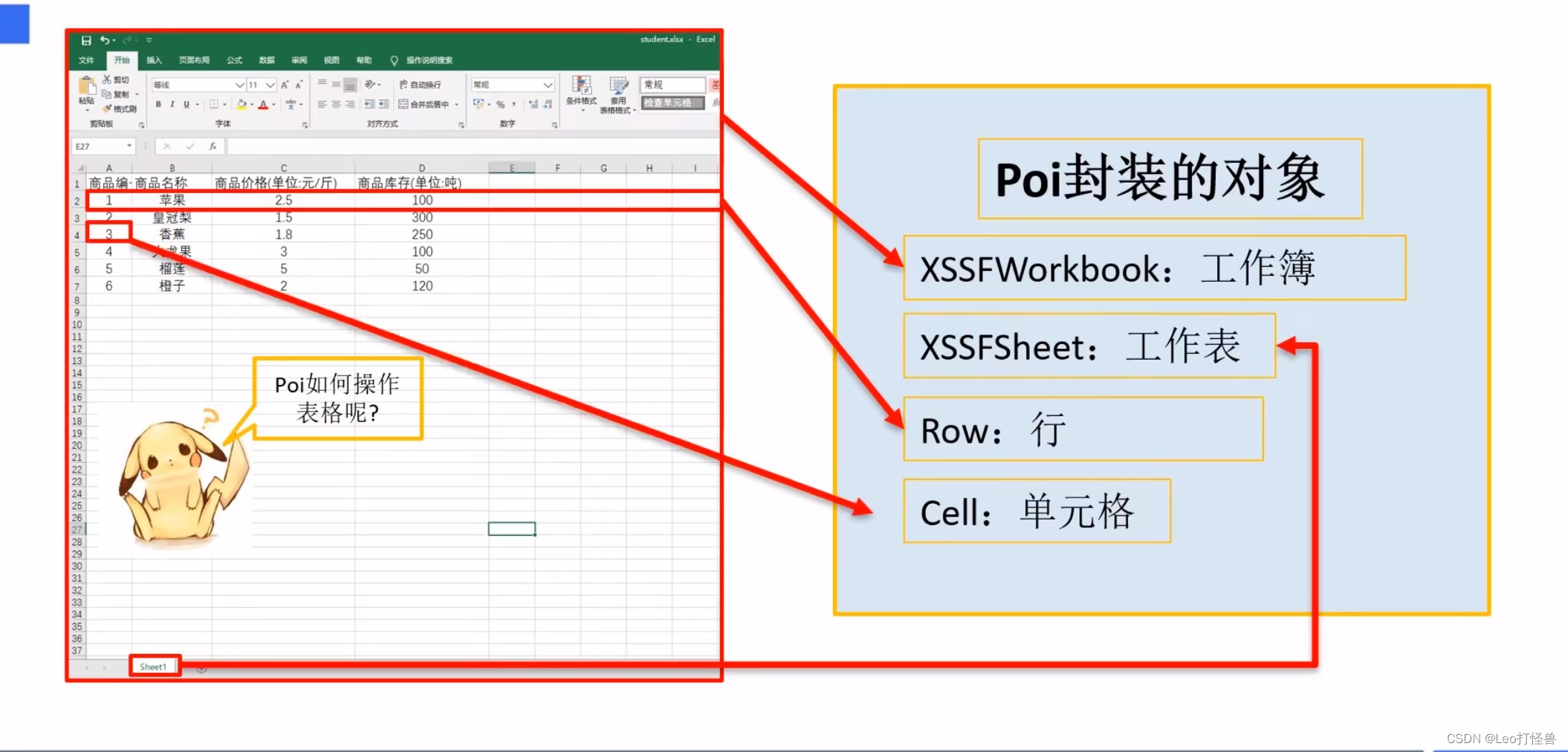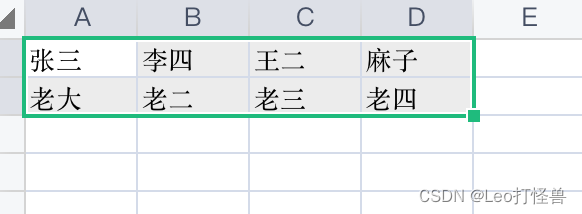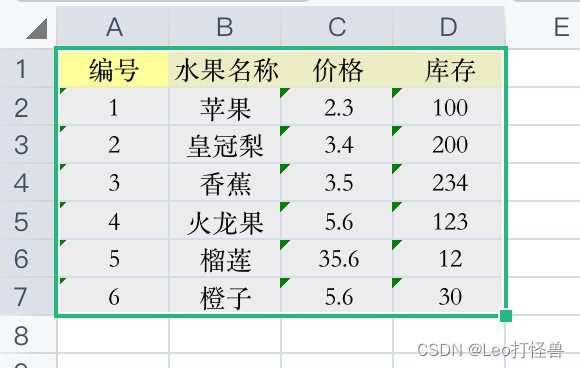了解下poi包

第一步 创建一个maven项目,导poi包
<dependency>
<groupId>org.apache.poi</groupId>
<artifactId>poi</artifactId>
<version>3.14</version>
</dependency>
<dependency>
<groupId>org.apache.poi</groupId>
<artifactId>poi-ooxml</artifactId>
<version>3.14</version>
</dependency>
了解下poi包中对象对应Excel表的中位置

第二步 实现对Excel文件的读取和写入
一.从Excel文件中读取数据
读取步骤:
1.创建工作薄
2.获取工作表
3.遍历工作表获取 行对象
4.遍历行对象获取 单元格对象
5.获取单元格中的值
6.释放资源
代码实现读取Excel
//1.获取工作薄 (这里文件的路径用的是绝对路径)
XSSFWorkbook workbook = new XSSFWorkbook("/Users/xxx/Desktop/code/excel1.xlsx");
//2。获取工作表
XSSFSheet sheet = workbook.getSheetAt(0);
//3.获取行
for (Row row : sheet) {
//4.获取单元格
for (Cell cell : row) {
//5.获取单元格中的值
String stringCellValue = cell.getStringCellValue();
//打印输出
System.out.println(stringCellValue);
}
}
//6.释放资源
workbook.close();
//上述代码的 步骤3,4,5 也可以用使用索引的方式来获取单元格的值
// 替换步骤3,4,5 的代码
// 获取行数
int lastRowNum = sheet.getLastRowNum();
//循环遍历
for (int i = 0; i <= lastRowNum; i++) {
//获取第(i+1)行
XSSFRow row = sheet.getRow(i);
if (row != null) {
//获取本行有多少个单元格
int cellNum = (int) row.getLastCellNum();
//循环遍历
for (int j = 0; j <= cellNum; j++) {
// 获取第j+1个单元格
XSSFCell cell = row.getCell(j);
if (cell != null) {
//获取单元格的内容,转成字符串
String stringCellValue = cell.getStringCellValue();
//打印输出
System.out.println(stringCellValue);
}
}
}
}
针对这样的Excel表格:

上述代码打印输出:
你好
我的
世界
Process finished with exit code 0
二.向Excel文件中写入数据
写入步骤
1.创建一个Excel文件
2.创建工作表
3.创建行
4.创建单元格 并赋值
5.通过输出流将对象下载到本地磁盘
6.释放资源
代码实现写入Excel
//1.创建工作博
XSSFWorkbook workbook = new XSSFWorkbook();
//2。创建工作表
XSSFSheet sheet = workbook.createSheet("工作表1");
//3。创建行
//第一行
XSSFRow row = sheet.createRow(0);
//4。创建单元格,并赋值
XSSFCell cell = row.createCell(0);
cell.setCellValue("张三");
row.createCell(1).setCellValue("李四");
row.createCell(2).setCellValue("王二");
row.createCell(3).setCellValue("麻子");
//第二行
XSSFRow row2 = sheet.createRow(1);
row2.createCell(0).setCellValue("老大");
row2.createCell(1).setCellValue("老二");
row2.createCell(2).setCellValue("老三");
row2.createCell(2).setCellValue("老四");
//5.输出流 输出
FileOutputStream fos = new FileOutputStream("/Users/xxx/Desktop/code/excel2.xlsx");
//按照路径 输出excel表
workbook.write(fos);
//6.刷新流,释放资源
fos.flush();
fos.close();
//关闭资源
workbook.close();
输出效果图

加强练习(集合导出Excel表,读取Excel表封装成集合)
要读取的Excel表内容

代码实现读取Excel文件,输出集合
//1.创建工作薄
XSSFWorkbook workbook = new XSSFWorkbook("/Users/xxx/Desktop/code/excelDemo.xlsx");
//2.获取工作表
XSSFSheet sheet = workbook.getSheetAt(0);
//Fruit对应表头的类对象
List<Fruit> list = new ArrayList<>();
//3.解析excel表
//第一行表头数据不要
int rowNum = sheet.getLastRowNum();
for (int i = 1; i <= rowNum; i++) {
XSSFRow row = sheet.getRow(i);
if (row != null) {
Fruit fruit = new Fruit();
XSSFCell cell0 = row.getCell(0); //编号
XSSFCell cell1 = row.getCell(1); //水果名
XSSFCell cell2 = row.getCell(2); //水果价格
XSSFCell cell3 = row.getCell(3); //水果库存
Double cellValue = cell0.getNumericCellValue();
fruit.setId(cellValue.intValue());
fruit.setName(cell1.getStringCellValue());
fruit.setPrice(cell2.getNumericCellValue());
Double cellValue1 = cell3.getNumericCellValue();
fruit.setInventory(cellValue1.intValue());
list.add(fruit);
}
}
//4.释放资源
workbook.close();
//5.打印输出
System.out.println("list:" + list);
//输出内容
/*
list:
[Fruit:{id=1, name='苹果', price=2.3, inventory=100},
Fruit:{id=2, name='皇冠梨', price=3.4, inventory=200},
Fruit:{id=3, name='香蕉', price=3.5, inventory=234},
Fruit:{id=4, name='火龙果', price=5.6, inventory=123},
Fruit:{id=5, name='榴莲', price=35.6, inventory=12},
Fruit:{id=6, name='橙子', price=5.6, inventory=30}]
*/
//Fruit对应表头的类对象
//get,set,toString方法自己生成哈
public class Fruit {
private Integer id;
private String name;
private double price;
private Integer inventory;
}
// 上述代码的步骤 3替换下面代码
int lastRowNum = sheet.getLastRowNum();
//第一行数据(表头) 不要
for (int i = 1; i <= lastRowNum; i++) {
XSSFRow row = sheet.getRow(i);
//避免空指针
if (row != null) {
Fruit fruit = new Fruit();
/*List<String> cellList = new ArrayList<>();
for (Cell cell : row) {
if (cell != null) {
//避免 数据类型转换异常
cell.setCellType(Cell.CELL_TYPE_STRING);
String cellValue = cell.getStringCellValue();
cellList.add(cellValue);
}
}
if (cellList.size() > 0) {
fruit.setId(Integer.parseInt(cellList.get(0)));
fruit.setName(cellList.get(1));
fruit.setPrice(Double.valueOf(cellList.get(2)));
fruit.setInventory(Integer.parseInt(cellList.get(3)));
}*/
//第二种方法 使用索引
int cellNum = row.getLastCellNum();
for (int j = 0; j <= cellNum; j++) {
XSSFCell cell = row.getCell(j);
if (cell != null) {
cell.setCellType(Cell.CELL_TYPE_STRING);
if (j == 0) {
fruit.setId(Integer.parseInt(cell.getStringCellValue()));
} else if (j == 1) {
fruit.setName(cell.getStringCellValue());
} else if (j == 2) {
fruit.setPrice(Double.valueOf(cell.getStringCellValue()));
} else {
fruit.setInventory(Integer.parseInt(cell.getStringCellValue()));
}
}
}
list.add(fruit);
}
}
代码根据集合,导出Excel文件
//1.创建工作薄
XSSFWorkbook workbook = new XSSFWorkbook();
//2.创建工作表
XSSFSheet sheet = workbook.createSheet("工作表1");
XSSFCellStyle style = workbook.createCellStyle();
// 背景色: 浅黄色
style.setFillForegroundColor(IndexedColors.LIGHT_YELLOW.getIndex());
// 背景色填充样式:单色填充
style.setFillPattern(FillPatternType.SOLID_FOREGROUND);
//水平居中
style.setAlignment(HorizontalAlignment.CENTER);
//垂直居中
style.setVerticalAlignment(VerticalAlignment.CENTER);
//3.创建行
//首先创建第一行
XSSFRow row = sheet.createRow(0);
//创建第一行的单元格
XSSFCell rowCell0 = row.createCell(0);
rowCell0.setCellStyle(style);
rowCell0.setCellValue("编号");
XSSFCell rowCell1 = row.createCell(1);
rowCell1.setCellStyle(style);
rowCell1.setCellValue("水果名称");
XSSFCell rowCell2 = row.createCell(2);
rowCell2.setCellStyle(style);
rowCell2.setCellValue("价格");
XSSFCell rowCell3 = row.createCell(3);
rowCell3.setCellStyle(style);
rowCell3.setCellValue("库存");
XSSFCellStyle cellStyle = workbook.createCellStyle();
//水平居中
cellStyle.setAlignment(HorizontalAlignment.CENTER);
//垂直居中
cellStyle.setVerticalAlignment(VerticalAlignment.CENTER);
// 然后遍历水果集合,写数据到excel表上
for (int i = 0; i < list.size(); i++) {
//获取水果信息
Fruit fruit = list.get(i);
//创建excel的行,由于第一行已经创建过,所以这里从 索引为i+1的开始
XSSFRow sheetRow = sheet.createRow(i + 1);
//创建单元格,赋值
//第一种方式
/* XSSFCell cell0 = sheetRow.createCell(0);
cell0.setCellValue(fruit.getId().toString());
cell0.setCellStyle(cellStyle);
XSSFCell cell1 = sheetRow.createCell(1);
cell1.setCellValue(fruit.getName());
cell1.setCellStyle(cellStyle);
XSSFCell cell2 = sheetRow.createCell(2);
cell2.setCellValue(String.valueOf(fruit.getPrice()));
cell2.setCellStyle(cellStyle);
XSSFCell cell3 = sheetRow.createCell(3);
cell3.setCellValue(fruit.getInventory().toString());
cell3.setCellStyle(cellStyle);*/
//第二种方式
for (int g = 0; g < 4; g++) {
XSSFCell cell = sheetRow.createCell(g);
cell.setCellStyle(cellStyle);
if (g == 0) {
cell.setCellValue(fruit.getId().toString());
} else if (g == 1) {
cell.setCellValue(fruit.getName());
}else if (g==2){
cell.setCellValue(String.valueOf(fruit.getPrice()));
}else{
cell.setCellValue(fruit.getInventory().toString());
}
}
}
FileOutputStream out = new FileOutputStream("/Users/xxxx/Desktop/code/excelWriteDemo6.xlsx");
workbook.write(out);
//刷新释放资源
out.flush();
out.close();
workbook.close();
导出Excel文件内容和格式

单元格样式设计
//1.创建工作薄
XSSFWorkbook workbook = new XSSFWorkbook();
//2.创建工作表
XSSFSheet sheet = workbook.createSheet("工作表1");
//3.创建单元格样式
XSSFCellStyle style = workbook.createCellStyle();
//填充背景色
// 背景色: 浅黄色
cellStyle.setFillForegroundColor(IndexedColors.LIGHT_YELLOW.getIndex());
// 背景色填充样式:单色填充
cellStyle.setFillPattern(FillPatternType.SOLID_FOREGROUND);
//设置样式布局
// 水平布局:居中
cellStyle.setAlignment(HorizontalAlignment.CENTER);
// 垂直布局:居中
cellStyle.setVerticalAlignment(VerticalAlignment.CENTER);
//设置边框
// 上薄边框
cellStyle.setBorderTop(BorderStyle.THIN);
// 下厚边框
cellStyle.setBorderBottom(BorderStyle.DOUBLE);
// 左薄边框
cellStyle.setBorderLeft(BorderStyle.THIN);
// 右厚边框
cellStyle.setBorderRight(BorderStyle.DOUBLE);
// 下边框:白色
cellStyle.setBottomBorderColor(IndexedColors.WHITE.getIndex());
// 右边框:绿色
cellStyle.setRightBorderColor(IndexedColors.GREEN.getIndex());
// 文本自动换行
cellStyle.setWrapText(true);
//设置字体颜色,样式,关键代码:font.setColor(IndexedColors.BLACK.getIndex());
Font font = workbook.createFont();
// 加粗
font.setBold(false);
// 字体
font.setFontName("微软雅黑");
// 字体高度
font.setFontHeightInPoints((short) 14);
// 字体颜色:黑色
font.setColor(IndexedColors.BLACK.getIndex());
cellStyle.setFont(font);























 520
520











 被折叠的 条评论
为什么被折叠?
被折叠的 条评论
为什么被折叠?








